The South Plazas
By Geoffrey McCafferty (2008)
The most extensive excavations have taken place on the south side of the Great Pyramid, including the Patio of the Altars but also other platforms extending out from the Pyramid. Exiting the tunnels on the east side of the Pyramid, visitors walk south to the entrance to the South Plazas. Conserved architecture indicates a platform that projected out from the southeast corner of the Great Pyramid. Preserved plaster facades reproduce facing.talud-tablero buildings that may have been a ballcourt (Fig. 1).
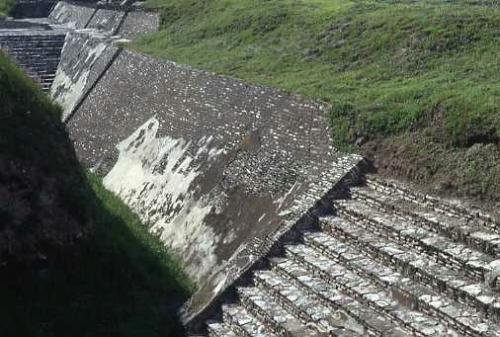
Figure 1: Platform on sourtheast corner of Pyramid, with preserved plaster from possible ballcourt
A series of overlapping construction phases include talud-tablero style architecture highly reminiscent of Teotihuacan canons (Fig, 2). Farther south is a mosaic patio floor, where the stone flooring creates patterns of filled squares (Fig. 3). This same pattern has been found in other parts of the site: 300 m east in a dirt road bed; 800 m north on the far side of the Edificio Rojo, and recently in excavations near the old railroad line. If all of these mosaic patios were contemporaneous and connected this would have been an enormous patio, and would aid in relative chronology across the ceremonial center.

Figure 2: Teotihuacan-style talud-tablero platform
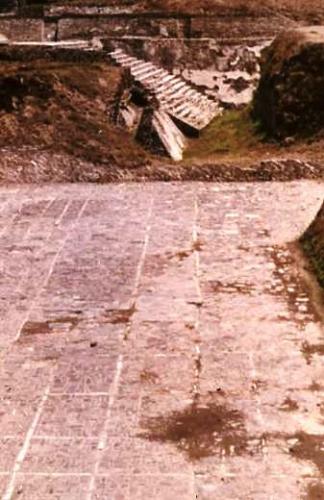
Figure 3: Sunken Patio south of Great Pyramid
The central plaza on the south side of the Great Pyramid is known as the Patio of the Altars (Fig. 4). It is located at what would have been the base of the south staircase of the Pyramid, with two major platforms jutting out from the Pyramid to delineate the open plaza space. The plaza underwent a series of sequential construction phases, described by Acosta (1970), as the open space became increasingly enclosed and elevated (Fig 5). A recurring stylistic element on the later platform facades is a greca motif (Fig. 6); in the Mixtec codices this motif is identified as ñuu, meaning 'great city' in much the same way as tollan in Nahuatl (Fig. 7).

Figure 4: Patio of the Altars, from Great Pyramid
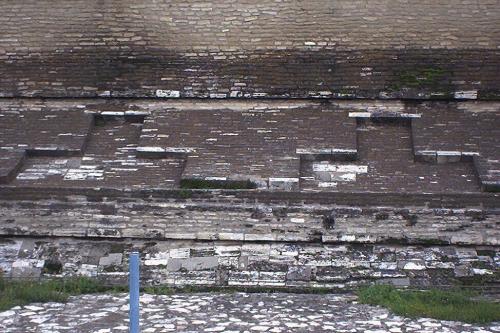
Figure 6: Greca frieze pattern around Patio of the Altars
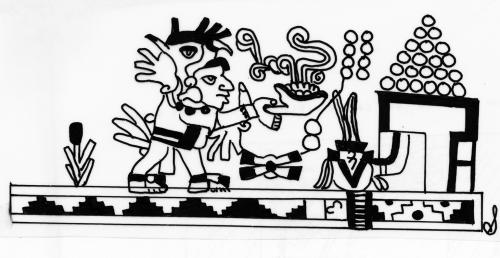
Figure 7: Offering incense at cattail-ñuu frieze place (Codex Bodley)
The Patio of the Altars gets its name from two massive stone altars that face one another across the plaza, on an east/west orientation. Altar/stela 1 is on the east side of the plaza, and is comprised of a a 30 cm slab of onyx as the altar base, and a 3.5 m tall stela that rises behind the altar (Fig. 8). The onyx stone originates from the Tecali region south of Puebla city, about 50 km from Cholula, and the transportation of these 10 ton slabs represents a considerable engineering feat. The stela is decorated wtih El Tajin-style volute patterns around a blank rectangular field in the center. Some traces of red paint were found in the carved volutes, but no evidence of painting exists from the blank field. The stela was shattered into more than a dozen fragments, possibly as an intentional destruction or termination ritual (Fig. 9).
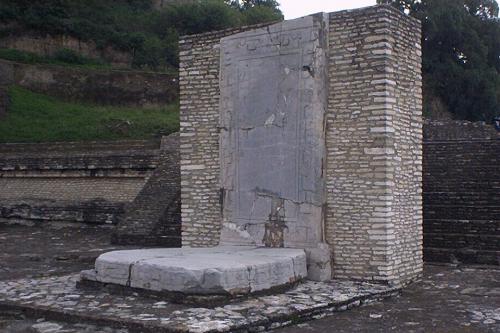
Figure 8: Altar/stela 1
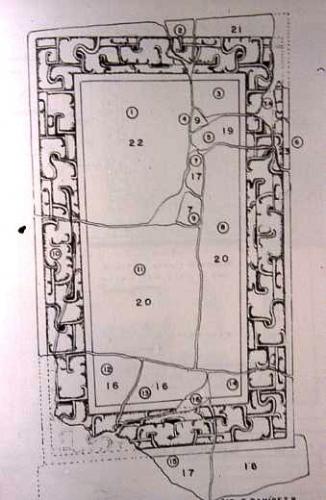
Figure 9: Detail drawing of Stela 1, showing volute pattern (from Acosta 1970)
Altar 2 is located on the west side of the plaza, at precisely a 24o north of west orientation from Altar 1. The altar is another massive slab of onyx, decorated around the edge with intertwined serpents (Figs. 10 and 11). Excavations beneath the altar discovered two child burials associated with bowls of the Cocoyotla Black on Natural type, consistent with an Epiclassic date.

Figure 10: Altar 2

Figure 11: Detail of Altar 2 with serpent head border
At the base of the south staircase of the Great Pyramid was another stone sculpture for what would have been the stela associated with Altar 2. In fact, excavations recovered the base of Stela 2 behind Altar 2, and when checked against the broken base of the stela from the south staircase they two pieces mended perfectly. The stela was erroneously erected at the base of the staircase, when it should have been set behind Altar 2 to create a symmetrical match with Altar/stela 1. Stela 2 also features a volute border (albeit more geometrical than Stela 1) around a blank center panel, and a pointed top (Fig. 12).
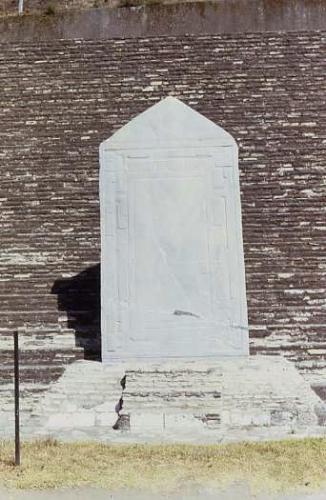
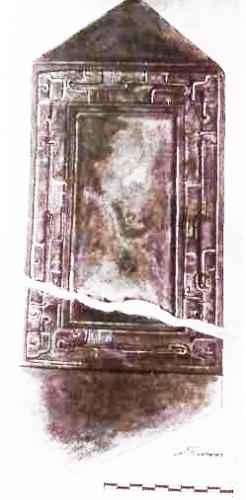
Figure 12: Stela 2
If Stela 2 were mounted behind Altar 2, as suggested is the correct position, then it would have the same orientation in respect to Stela 1as the Great Pyramid itself relative to the setting sun at the summer solstice. Thus the setting sun on the longest day of the year would cast a shadow from the pointed top of Stela 2 across the Patio of the Altars to the blank space on the face of Altar 1, making this a form of solar year 'sun-dial.' It should also be noted that this pattern of stela/altar groups are not common in central Mexico, but are a possible introduction from the Maya region.
Several additional monolithic stone sculptures are also found in the Patio of the Altars. A massive obelisk is located in the northeast corner of the Patio, on a stepped platform (Fig. 13). This stone is similar in form to sacrificial stones from the later Aztec culture, used for stretching victims of heart sacrifice. While this stone is too tall for such a function, it is possible that with a wooden scaffolding around its base it could have served as a sacrificial stone, elevated for public spectacle.
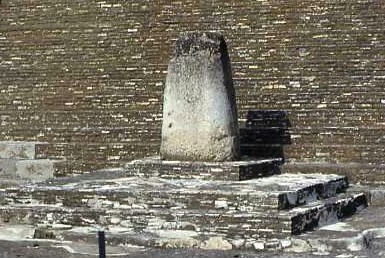
Figure 13: Possible sacrificial stone
An enigmatic stone sculpture is covered with white stucco. It has been alternatively described as a serpent head, or as a chacmool (Fig. 14). A clearer sculpture of a serpent head was originally found in the Patio of the Altars, but is now in the Puebla Regional Museum of INAH (Fig. 15). It features a 'key-stone' hook in the back, where it was likely set into a masonry wall, perhaps as part of a staircase balustrade (such as at the Pyramid of the Feathered Serpent in Teotihuacan), or with the open mouth it could even have been part of a ballcourt.
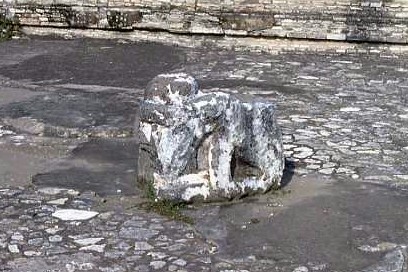
Figure 14: Stucco covered sculpture of possible serpent or chacmool
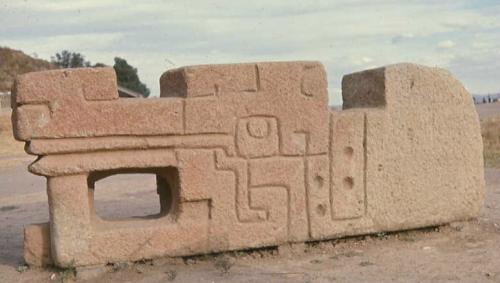
Figure 15: Serpent head with keystone hook
A large stone head is also found in the Patio of the Altars (Fig 16). No archaeological context is published for the discovery of this piece, though it rests on a thin layer of soil above the patio floor. It is possible that this head represents an altar discovered by Fray Motolinia on top of the Great Pyramid in 1531, as part of a shrine to a rain god, Chiconauquiahuitl. According to Motolinia, he rolled the altar off of the summit. If so, then the face on the stone may be that of a frog, corresponding to the frog depicted on top of the Great Pyramid in the Historia Tolteca-Chichimeca (Fig. 17). Another possibility is that this stone relates to an account by Veytia that the natives built the Great Pyramid as a pathway up into heaven, but God hurled a giant stone down to smash the top of the Pyramid as a warning.
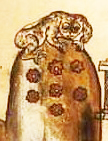
Figure 17: Detail of frog on Great Pyramid (from Historia Tolteca Chichimeca)
At the south end of the Patio of the Altars is a deep pit, with a miniature pyramid-altar in it. This was discovered in the 1960s when archaeologists of the Proyecto Cholula dug a long trench from the base of the Great Pyramid south in order to find a connection with the mosaic patio. Six levels of Patio construction were encountered (Acosta 1970), but no clear relationship with the mosaic patio, which threrefore predates the Patio of the Altars. In the process of digging the trench, however, the so-called 'Altar Mexica' was found. It is a small pyramid-altar (Fig. 18), similar in style to the one found at the Patio of the Carved Skulls on the northeast platform of the Great Pyramid. Inside were skeletal remains of a cremation burial in a large cazuela, a parts of a hollow ceramic anthropomorphic sculpture, and several ceramic vessels of the Cocoyotla Black on Natural type and a polychrome with Gulf Coast style volutes (Fig 19; also related to the designs on Stela 1). These ceramics help date the altar, and therefore the Patio of the Altars, to the Epiclassic period. This dating therefore clearly predates the Mexica in central Mexico, and a better name for the feature is therefore 'Altar Olmeca' since this would correspond to the period when the Olmeca-Xicallanca controlled Cholula.
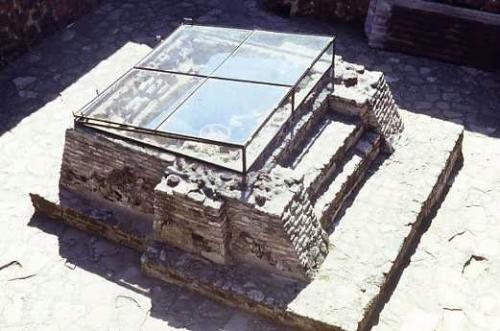
Figure 18: Altar Olmeca on early level of Patio of the Altars
Polychrome murals were found on the tableros of different stages of the platform construction associated with the Patio of the Altars. A recurring pattern of diagonal bands and 'star' motifs were found on several levels (Fig. 20); multi-color diagonal bands are a stylistic theme used in the Mixtec codices for 'stone.'

Figure 20: Tablero panel with multi-color diagonal bands
The most dramatic series of murals were the famous Bebedores murals, representing in two panels dozens of seated individuals in various states of inebriation (Fig 21), to the point that some are converting into their animal co-essences (Fig 22). It is unfortunate that these murals have never been adequately analyzed, since they are among the most extensive in all of Mesoamerica. The theme of drinkers seated on tapestry rugs suggests a ceremonial event with no clear parallel in Mesoamerican art.
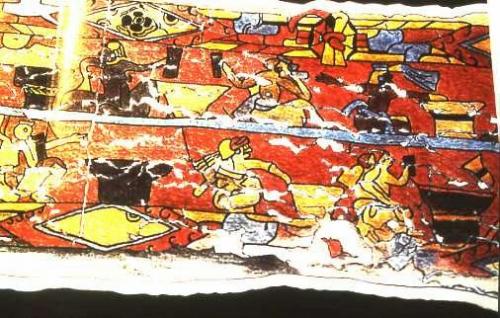
Figure 21: Section of Bebedores mural (artist's reproduction)
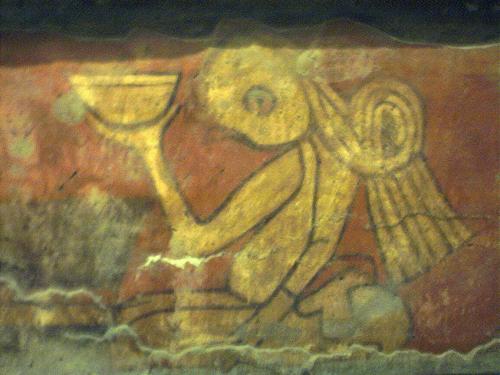
Figure 22: Detail of Bebedores mural, showing drinker transforming into animal co-essence
Another section of mural is described by Acosta (1970) as a long representation of a multi-color feathered serpent. Unfortunately this mural no longer exists at the site, and there are no known drawings or photographs. Since Cholula was widely regarded as the center for the worship of Quetzalcoatl it is indeed sad that only representation in public art has been lost.
Monumental construction continued to the southwest of the Great Pyramid. Huge platforms rise 20 m above the original ground surface (Fig. 23), and overlapping walls indicate a tumultuous construction sequence (Fig. 24). Another miniature pyramid-altar is located in the southwest plaza (Fig. 25), and at the base there was once a small dedication of two adolescent skeletons with significantly deformed skulls (Fig. 26). Interestingly, a web-site uses these children's skeletons as a proof of alien intervention in prehispanic Mexico (http://ufologie.net/htm/cholula.htm).
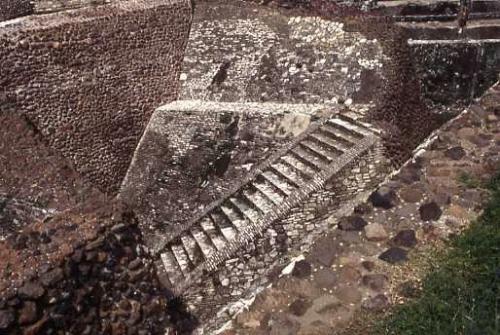
Figure 23: Southwest platform
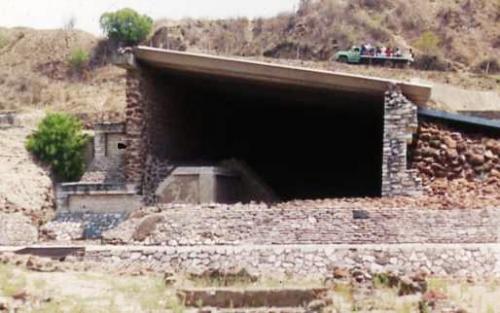
Figure 24: Multiple levels of construction and demolition
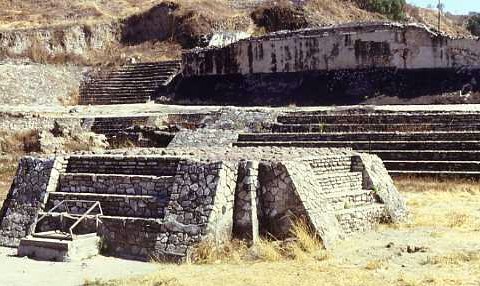
Figure 25: Radial platform in patio on southwest side of Great Pyramid

Figure 26: Skeletons of adolescents with cranial modification
Another patio group visible from the southwest side of the ceremonial precinct is on a platform associated with the Patio of the Altars (Fig. 27). Although isolated from areas of public access, this patio group is significant because of subsequent rescue excavations conducted by Sergio Suarez Cruz in the early 1980s. In the process of constructing a drainage system to remove rainwater from the patio, an adult male burial was discovered. Unusual tabular erect style cranial and dental modifications with teeth inlaid with jade and pyrite led Suarez Cruz (1985) to suggest that the individual was Maya, and therefore perhaps a merchant or priest (Fig. 28). He dated the burial to the Late Classic period, though the presence of Tecola Polished pottery among the grave goods indicates a slightly earlier date. The grave goods are now on display at the site museum on the north side of the Great Pyramid (Fig. 29).
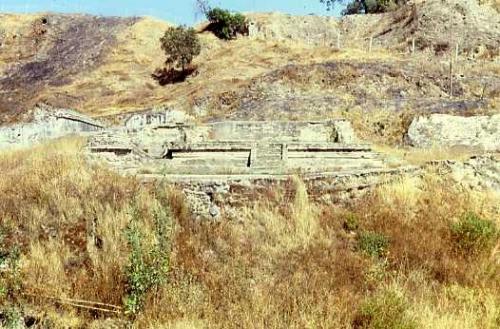
Figure 27: Patio group on platform of Patio of the Altars
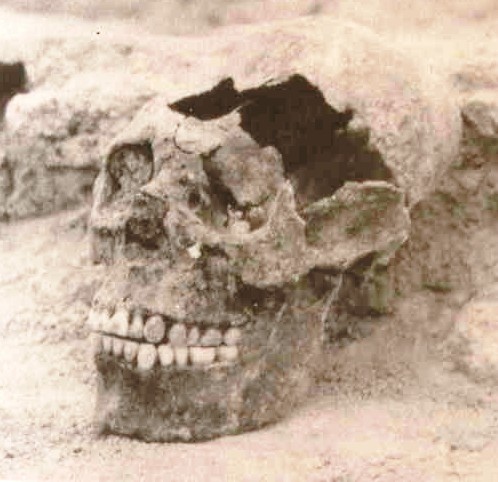
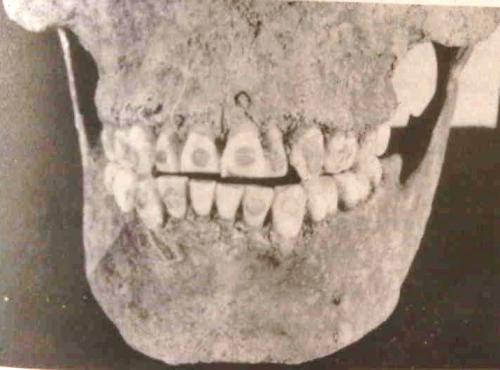
Figure 28: Skull of adult male showing tabular erect modification and inlaid teeth

Figure 29: Grave goods associated with 'Maya' individual
As the visitor leaves the Sourth Plaza area they have a final view of the complexity of the architectural history of the Great Pyramid, with multiple building stages overlying one another as seen in sequential platform bases (Fig. 30).

Figure 30: Platform base on southwest corner of Great Pyramid

